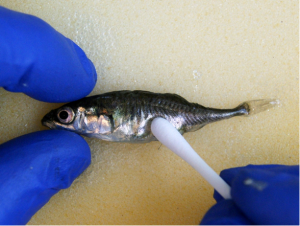Citizen Writes
Research hot topics
Refining DNA collection from fish by skin swabbing
2021-05-10

By Dr Will Norton
Model fish species are extensively used for biomedical research. The most popular technique to collect DNA from fish is fin clipping. Unfortunately however, this has the potential to cause harm to the animals. We investigated an alternative technique, skin swabbing, which causes fewer changes to stress axis activation and behaviour.
Changes to animal health and welfare can alter their behaviour and physiology. Animal welfare is an ethical responsibility for researchers, as well as being required in order to collect reliable and reproducible results. Many lab studies use small model fish species such as zebrafish or sticklebacks because of their ease of maintenance and similarity to other vertebrates. For example, we study aggression and related human diseases using zebrafish as a model organism.
DNA is frequently collected from animals to allow identification by genotyping. The current standard procedure to collect DNA from fish is fin clipping. Fish are anaesthetised and a small part of the caudal fin is cut off. However, recent research has shown that fin clipping can alter behaviour, increase ventilation, decrease feeding and trigger release of the primary stress hormone cortisol. Fin clipping may therefore decrease fish welfare in addition to altering experimental data that is collected afterwards.
Our previous research has shown that at an alternative technique can be used to collect DNA from small fish kept in the lab – skin swabbing. Swabbing involves using a cotton bud to collect mucus from the fish’s body before extracting DNA. In this project, shared between the University of Leicester and Nottingham Trent University, we directly compared skin swabbing to fin clipping to see whether mucus collecting was less harmful to the animals.
We found that both techniques are stressful for fish, but that skin swabbing triggers fewer changes in stress axis activation, gene expression and behaviour. It also leads to a smaller variation in the data collected after DNA sampling meaning that fewer animals are needed to collect statistically significant results. In summary, skin swabbing is a refined technique for DNA collection, with the potential to have an extremely wide impact upon fish health and welfare. Our next steps are to promote these findings across the research sector.